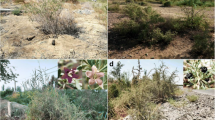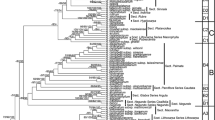Abstract
To investigate the impacts of ancient geological and climatic events on the evolutionary history of the Aconitum nemorum species group, including A. nemorum s. str., A. karakolicum, and A. soongoricum; a total of 18 natural populations with 146 individuals were sampled, mainly from grassy slopes or the coniferous forest understory of the Tianshan Mountain Range and its surroundings. Two cpDNA intergenic spacer regions (trnS-trnG and psbA-trnH) were sequenced and 16 haplotypes were identified. These were clustered into three divergent lineages which almost entirely corresponded to the three species. Analysis of molecular variance indicated restricted gene flow, mainly among species. High levels of genetic distance were detected among eastern populations in A. nemorum s. str. and A. karakolicum from spatial genetic landscape analysis. Neutral tests and mismatch distribution analysis suggest that A. nemorum s. str. experienced demographic expansions during interglacial periods. Based on haplotype distribution and the median-joining network, it was inferred that this species underwent two periods of eastward expansion. Our molecular dating indicates that the lineages of the complex separated during the period of the late Tertiary to late Pleistocene (11.74–0.064 million years ago), which was most likely triggered by recent rapid uplift of the Tianshan Mountains, while genetic variation at the intra-specific level might be attributed to climatic cycles in the late Quaternary.




Similar content being viewed by others
References
Avise JC (2000) Phylogeography: the history and formation of species. Harvard University Press, Cambridge
Bandelt HJ, Forster P, Rohl A (1999) Median-joining networks for inferring intraspecific phylogenies. Mol Biol Evol 16:37–48
Brouns G, De Wulf A, Constales D (2003) Delaunay triangulation algorithms useful for multibeam echosounding. J Surv Eng-Asce 129:79–84
Clark MK, House MA, Royden LH, Whipple KX, Burchfiel BC, Zhang X, Tang W (2005) Late Cenozoic uplift of southeastern Tibet. Geol 33:525–528
Cun YZ, Wang XQ (2010) Plant recolonization in the Himalaya from the southeastern Qinghai-Tibetan Plateau: geographical isolation contributed to high population differentiation. Mol Phylogenet Evol 56:972–982
Doyle JJ, Doyle JL (1987) A rapid DNA isolation procedure for small quantities of fresh leaf tissue. Phytochem Bull 19:11–15
Drummond AJ, Rambaut A (2007) BEAST: bayesian evolutionary analysis by sampling trees. BMC Evol Biol 7:214
Espíndola A, Pellissier L, Maiorano L, Hordijk W, Guisan A, Alvarez N (2012) Predicting present and future intra-specific genetic structure through niche hindcasting across 24 millennia. Ecol Lett 15:649–657
Excoffier L, Laval G, Schneider S (2005) Arlequin (version 3.0): an integrated software package for population genetics data analysis. Evol Bioinform 1:47–50
Fu YX (1997) Statistical tests of neutrality of mutations against population growth, hitchhiking and background selection. Genetics 147:915–925
Group of Comprehensive Survey for Xinjiang Resources Development, Chinese Academy of Sciences (1989) Geology and environment in the Quaternary period in Xinxjiang. China Agriculture Press, Beijing
Guan KJ, Xiao PG, Wang WC, Pang KY (1979) Flora of China, vol 27. Science Press, Beijing
Guindon S, Dufayard J-F, Lefort V, Anisimova M, Hordijk W, Gascuel O (2010) New algorithms and methods to estimate maximum-likelihood phylogenies: assessing the performance of PhyML 3.0. Syst Biol 59:307–321
Hamilton MB (1999) Four primer pairs for the amplification of chloroplast intergenic regions with intraspecific variation. Mol Ecol 8:521–523
Hardy ME, Grady JM, Routman EJ (2002) Intraspecific phylogeography of the slender madtom: the complex evolutionary history of the Central Highlands of the United States. Mol Ecol 11:2393–2403
Hewitt G (2000) The genetic legacy of the Quaternary ice ages. Nature 405:907–913
Hewitt G (2004) Genetic consequences of climatic oscillations in the Quaternary. Philos T Roy Soc B 359:183–195
Jia DR, Abbott RJ, Liu TL, Mao KS, Bartish IV, Liu JQ (2012) Out of the Qinghai-Tibet Plateau: evidence for the origin and dispersal of Eurasian temperate plants from a phylogeographic study of Hippophae rhamnoides (Elaeagnaceae). New Phytol 194:1123–1133
Kelchner SA, Thomas MA (2007) Model use in phylogenetics: nine key questions. Trends Ecol Evol 22:87–94
Li LQ (1995) The geographical distribution of Subfam. Helleboroideae (Ranunculaceae). Acta Phytotaxon Sin 33:537–555
Li ZH, Chen J, Zhao GF, Guo YP, Kou YX, Ma YZ, Wang G, Ma XF (2012) Response of a desert shrub to past geological and climatic change: a phylogeographic study of Reaumuria soongarica (Tamaricaceae) in western China. J Syst Evol 50:351–361
Librado P, Rozas J (2009) DnaSP v5: a software for comprehensive analysis of DNA polymorphism data. Bioinformatics 25:1451–1452
Liu YF, Wang Y, Huang HW (2009) Species-level phylogeographical history of Myricaria plants in the mountain ranges of western China and the origin of M. laxiflora in the Three Gorges mountain region. Mol Ecol 18:2700–2712
Liu JQ, Sun YS, Ge XJ, Gao LM, Qiu YX (2012) Phylogeographic studies of plants in China: advances in the past and directions in the future. J Syst Evol 50:267–275
Luo Y, Zhang F, Yang QE (2005) Phylogeny of Aconitum subgenus Aconitum (Ranunculaceae) inferred from ITS sequences. Plant Syst Evol 252(1–2):11–25
Manzano P, Malo JE (2006) Extreme long-distance seed dispersal via sheep. Front Ecol Enviro 4:244–248
Meng HH, Zhang ML (2011) Phylogeography of Lagochilus ilicifolius (Lamiaceae) in relation to Quaternary climatic oscillation and aridification in northern China. Biochem Syst Ecol 39:787–796
Miller MP (2005) Alleles In Space (AIS): computer software for the joint analysis of interindividual spatial and genetic information. J Hered 96:722–724
Muellner AN, Tremetsberger K, Stuessy T, Baeza CM (2005) Pleistocene refugia and recolonization routes in the southern Andes: insights from Hypochaeris palustris (Asteraceae, Lactuceae). Mol Ecol 14:203–212
Nathan R, Muller-Landau HC (2000) Spatial patterns of seed dispersal, their determinants and consequences for recruitment. Trends Ecol Evol 15:278–285
Nie GZ, Liu JQ, Guo ZT (1996) The major stratigraphic boundaries and climatic events in Weinan loess section since 0.15 Ma BP: based on chronological evidences. Quat Sci 16:221–231
Posada D, Crandall KA (1998) MODELTEST: testing the model of DNA substitution. Bioinformatics 14:817–818
Qiu YX, Li Y, Zhai SN, Guo YP, Ge XJ, Comes HP (2011a) Glacial survival east and west of the ‘Mekong-Salween Divide’ in the Himalaya-Hengduan Mountains region as revealed by AFLPs and cpDNA sequence variation in Sinopodophyllum hexandrum (Berberidaceae). Mol Phylogenet Evol 59:412–424
Qiu YX, Fu CX, Comes HP (2011b) Plant molecular phylogeography in China and adjacent regions: tracing the genetic imprints of Quaternary climate and environmental change in the world’s most diverse temperate flora. Mol Phylogenet Evol 59:225–244
Rambaut A, Drummond A (2007) Tracer v1.4. http://beast.bio.ed.ac.uk/Tracer
Rogers AR, Harpending H (1992) Population-growth makes waves in the distribution of pairwise genetic-differences. Mol Biol Evol 9:552–569
Ronquist F, Teslenko M, van der Mark P, Ayres DL, Darling A, Hohna S, Larget B, Liu L, Suchard MA, Huelsenbeck JP (2012) MrBayes 3.2: efficient Bayesian phylogenetic inference and model choice across a large model space. Syst Biol 61:539–542
Sang T, Crawford DJ, Stuessy TF (1997) Chloroplast DNA phylogeny, reticulate evolution, and biogeography of Paeonia (Paeoniaceae). Am J Bot 84:1120–1136
Schaal BA, Hayworth DA, Olsen KM, Rauscher JT, Smith WA (1998) Phylogeographic studies in plants: problems and prospects. Mol Ecol 7:465–474
Schneider S, Excoffier L (1999) Estimation of past demographic parameters from the distribution of pairwise differences when the mutation rates very among sites: application to human mitochondrial DNA. Genetics 152:1079–1089
Shi ZT, Fang XM, Song YG, An ZS, Yang SL (2006) Loess sediments in the north slope of Tianshan Mountains and it’s indication of desertification since Middle Pleistocene. Mar Geol Quat Geol 36:109–114
Slatkin M, Hudson RR (1991) Pairwise comparisons of mitochondrial-DNA sequences in stable and exponentially growing populations. Genetics 129:555–562
Stewart JR, Lister AM, Barnes I, Dalén L (2010) Refugia revisited: individualistic responses of species in space and time. Proc R Soc B 277:661–671
Su ZH, Zhang ML, Cohen J (2012) Phylogeographic and demographic effects of Quaternary climate oscillations in Hexinia polydichotoma (Asteraceae) in Tarim Basin and adjacent areas. Plant Syst Evol
Sun JM, Zhu RX, Bowler J (2004) Timing of the Tianshan Mountains uplift constrained by magnetostratigraphic analysis of molasse deposits. Earth Planet Sci Lett 219:239–253
Sun H, Zhang YH, Volis S (2010) Chloroplast phylogeny and phylogeography of Stellera chamaejasme on the Qinghai-Tibet Plateau and in adjacent regions. Mol Phylogenet Evol 57:1162–1172
Tajima F (1989) Statistical-method for testing the neutral mutation hypothesis by DNA polymorphism. Genetics 123:585–595
Tang Z, Wang Z, Zheng C, Fang J (2006) Biodiversity in China’s Mountains. Front Ecol Environ 4:347–352
Thompson JD, Gibson TJ, Plewniak F, Jeanmougin F, Higgins DG (1997) The CLUSTAL_X windows interface: flexible strategies for multiple sequence alignment aided by quality analysis tools. Nucleic Acids Res 25:4876–4882
Wang LN, Ji JQ, Sun DX (2010) The uplift history of south-western Tianshan: implications from AFT analysis of detrital samples. Chin J of Geophys 53:931–945
Wang LY, Abbott RJ, Zheng W, Chen P, Wang YJ, Liu JQ (2009) History and evolution of alpine plants endemic to the Qinghai-Tibetan Plateau: Aconitum gymnandrum (Ranunculaceae). Mol Ecol 18:709–721
Watson DF (1992) Contouring: a guide to the analysis and display of spatial data (with programs on diskette). Pergamon Press, Oxford
Wolfe KH, Li WH, Sharp PM (1987) Rates of Nucleotide substitution vary greatly among plant mitochondrial, chloroplast, and nuclear Dnas. Proc Natl Acad Sci USA 84:9054–9058
Wulff EV (1943) An introduction to historical plant geography. Chronica Botanica Company, Waltham
Xu T, Abbott RJ, Milne RI, Mao K, Du FK, Wu G, Ciren Z, Miehe G, Liu J (2010a) Phylogeography and allopatric divergence of cypress species (Cupressus L.) in the Qinghai-Tibetan Plateau and adjacent regions. BMC Evol Biol 10:194
Xu XK, Kleidon A, Miller L, Wang SQ, Wang LQ, Dong GC (2010b) Late Quaternary glaciation in the Tianshan and implications for palaeoclimatic change: a review. Boreas 39:215–232
Yan S, Mu G, Xu Y, Zhao Z (1998) Quaternary environmental evolution of the Lop Nur region, China. Acta Geographical Sinica 53:332–340
Zhang HX, Zhang ML (2012) Genetic structure of the Delphinium naviculare species group tracks Pleistocene climatic oscillations in the Tianshan Mountains, arid Central Asia. Palaeogeogr Palaeoclimatol Palaeoecol 353–355:93–103
Zhang YJ, Stock M, Zhang P, Wang XL, Zhou H, Qu LH (2008) Phylogeography of a widespread terrestrial vertebrate in a barely-studied Palearctic region: green toads (Bufo viridis subgroup) indicate glacial refugia in Eastern Central Asia. Genetica 134:353–365
Zhao JD, Liu SY, He YQ, Song YG (2009) Quaternary glacial chronology of the Ateaoyinake River Valley, Tianshan Mountains, China. Geomorphology 103:276–284
Zhou WW, Wen Y, Fu JZ, Xu YB, Jin JQ, Ding L, Min MS, Che J, Zhang YP (2012) Speciation in the Rana chensinensis species complex and its relationship to the uplift of the Qinghai-Tibetan Plateau. Mol Ecol 21:960–973
Acknowledgments
We are grateful to Kai-Qing Xie and Jian Zhang in Shihezi University for help in the material collection. Two anonymous reviewers and Dr. Isabel Sanmartin are deeply grateful for their helpful comment and suggestion on the manuscript. Funding was provided by CAS Important Direction for Knowledge Innovation Project (No. KZCX2-EW-305), and Xinjiang Institute of Ecology and Geography, Chinese Academy of Sciences.
Author information
Authors and Affiliations
Corresponding author
Electronic supplementary material
Below is the link to the electronic supplementary material.
606_2013_859_MOESM1_ESM.pdf
Supplementary Fig. S1 Maximum likelihood tree derived from trnS-trnG and psbA–trnH sequences. Bootstrap values larger than 50% are shown above branching points. Red, yellow and green font colors represent haplotypes belonging to A. soongoricum, A. karakolicum and A. nemorum s. str., respectively (PDF 264 kb)
606_2013_859_MOESM2_ESM.pdf
Supplementary Fig. S2 Bayesian Inference tree derived from trnS-trnG and psbA–trnH sequences. Posterior probabilities larger than 0.75 are shown above the branches. Red, yellow and green font colors represent haplotypes belonging to A. soongoricum, A. karakolicum and A. nemorum s. str., respectively (PDF 282 kb)
Rights and permissions
About this article
Cite this article
Jiang, XL., Zhang, ML., Zhang, HX. et al. Phylogeographic patterns of the Aconitum nemorum species group (Ranunculaceae) shaped by geological and climatic events in the Tianshan Mountains and their surroundings. Plant Syst Evol 300, 51–61 (2014). https://doi.org/10.1007/s00606-013-0859-x
Received:
Accepted:
Published:
Issue Date:
DOI: https://doi.org/10.1007/s00606-013-0859-x




